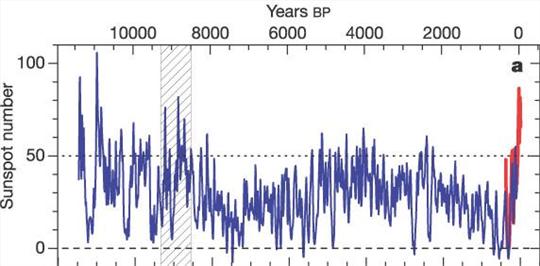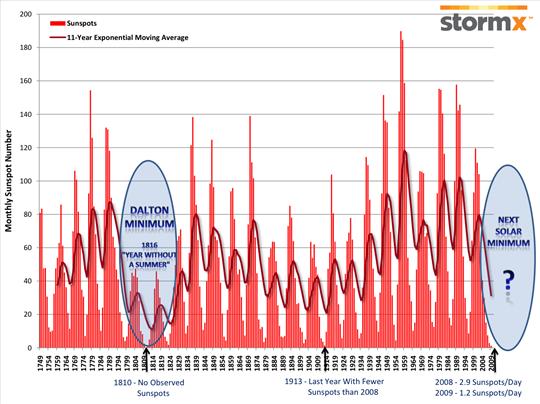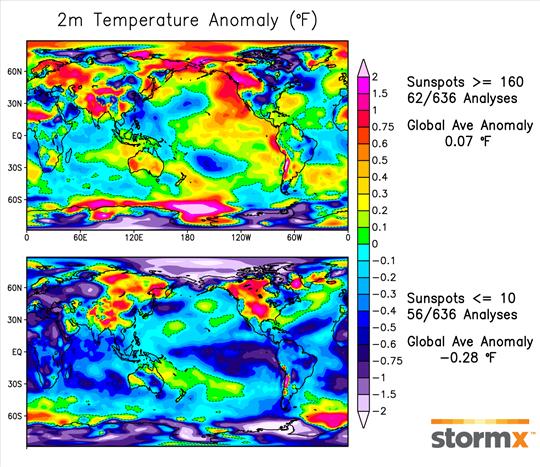Sunspots are relatively cooler and darker areas on the sun's surface caused by intense magnetic activity. Approximately every 11 years, the sun undergoes cyclic periods of high and low sunspot activity related to a 22-year reversal of the sun's magnetic field. From the sunspot maxima to the sunspot minima solar radiation impacting Earth decreases by approximately 0.1%. Although this seems like an insignificant change, such decreases in solar output over an extended period of time are integrated and can have considerable impacts on Earth's climate. Moreover, some radiative spectra such as ultraviolet and cosmic rays vary significantly more than 0.1% and can affect cloud cover and other feedbacks on the earth-climate system.
Occasionally, the sun undergoes periods lasting several decades when sunspots are less frequent or may not occur at all. The last significant period of decreased sunspot activity occurred from 1795 to 1830, known as the Dalton Minimum. During this period global temperatures decreased and after significant volcanic eruptions in 1816, temperatures plummeted across the Northern Hemisphere. 1816 became known as the "year without a summer". A severe frost in May 1816 destroyed most of the planted crops in North America, and in June two major snowstorms impacted New England and eastern Canada. Ice remained on lakes and rivers as far south as Pennsylvania through July and August.
The Dalton Minimum had a significant impact on global climate, but was a mild event relative to the Maunder Minimum, a period lasting from 1645-1715 when sunspots were 1/1000th of normal. The Maunder Minimum is thought to be the primary cause of the Little Ice Age, a period when glaciers advanced and bitterly cold winters occurred in many regions of the Northern Hemisphere. In 1780, the New York Harbor froze allowing people to walk from Manhattan to State Island. According to research by Solanki et al., sunspot activity during recent decades has been the highest in the past 8,000 years and has likely influenced climate during the 20th century.

Over the past several years, the sun has been entering another minimum in the 11-year sunspot cycle. However, the unforeseen and lingering absence of sunspots during the past year has raised concerns that another period like the Dalton Minimum could occur. The number of sunspots in 2008 was the 7th fewest since 1749, averaging only 2.9 sunspots/day. The most recent year with fewer sunspots was 95 years ago in 1913. Sunspots during the first three months of 2009 have remained exceptionally low, averaging only 1.2 sunspots/day. If this inactivity would persist throughout 2009, it would rank as the 2nd fewest since 1749, trailing only 1810 when no sunspots were observed.
The most reliable and widespread global weather observations have only been recorded since the mid 20th century. Unfortunately that is a period when generally high sunspot activity occurred, thus making it difficult to accurately quantify the impacts of decadal sunspot minima on climate. However, the regular reoccurrence of the 11-year sunspot cycle makes it possible to ascertain the short term impacts of sunspot minima and maxima on climate. Presumably, if short term climate is influenced every 11 years, then longer periods of sunspot inactivity would cause larger changes in climate. The availability of historical global weather observation analyses since 1948 allows us to compare surface temperatures during periods of high sunspot activity and periods of low sunspot activity. From 1948-2000, five complete solar cycles occurred and the 10th and 90th percentiles of sunspots each month were used to differentiate periods of low activity versus high activity. Temperature anomalies were averaged only when sunspots exceeded 160 (~ 90th percentile) and when sunspots were less than 10 (~ 10th percentile). It was found that the global average temperature anomalies during low sunspot periods were around 0.35°F cooler than during high sunspot periods. Even more significant is the notable impacts on the tropical east Pacific. La Nina is apparently favored during periods of low sunspots as surface temperatures averaged cooler than normal by more than 1°F over portions of the tropical east Pacific. The Storm Exchange science team will continue to monitor the current sunspot cycle and further expand our solar minima research to gain a better understanding of the impacts on agriculture and energy.





Reader Comments
to our Newsletter